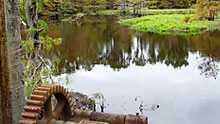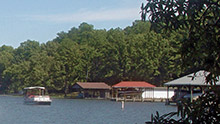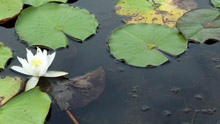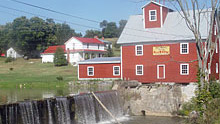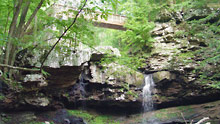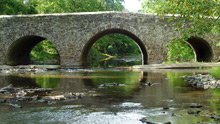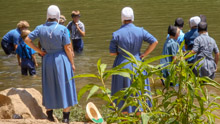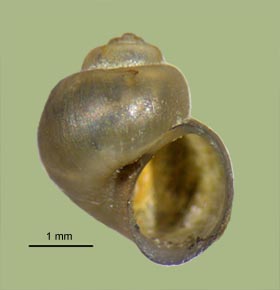> Habitat & Distribution
Spilochlamys turgida was one of the three hydrobiid species (along with Marstonia agarhecta and Notogillia sathon) described by Thompson (1969) as endemic to springs and spring-fed tributaries of the Ocmulgee River in the vicinity of Hawkinsville, Georgia. And like N. sathon, Thompson subsequently discovered several populations in tributaries of the upper Oconee drainage in Laurens County to the east. Unlike N. sathon, however, we are not aware of any S. turgida homologue in Chattahoochee/Flint drainages to the west. The range of Spilochlamys turgida does indeed appear to be very localized.
Watson (2000) characterized the habitat as "relatively undisturbed pools of springs or small streams," with substrate "mud-silt-sand mixture, sometimes with leaf litter and woody debris." Spilochlamys turgida demonstrates non-apparent rarity in our 17-state study area, FWGNA incidence rank I-3*.
> Ecology & Life History
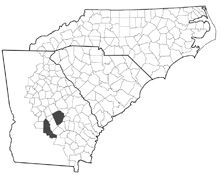 Hydrobiids seem to be rather nonspecific grazers of small particles (Dillon 2000: 94-97). They are typically dioecious, the males being characterized by a penis that arises from the neck. Females attach single eggs in spare, hemispherical capsules to solid substrates (Hershler 1994). No specific life history data are as yet available for S. turgida.
Hydrobiids seem to be rather nonspecific grazers of small particles (Dillon 2000: 94-97). They are typically dioecious, the males being characterized by a penis that arises from the neck. Females attach single eggs in spare, hemispherical capsules to solid substrates (Hershler 1994). No specific life history data are as yet available for S. turgida.
> Taxonomy & Systematics
Thompson (1969) described his new hydrobiid species turgida from Osewitchee Spring in Wilcox County, Ga, as bearing a shell distinguished by its ovate shape with depressed spire, strongly rounded, shouldered whorls. Details of its bladelike or spatulate (nymphophiline) penial morphology prompted Thompson to allocate turgida to Spilochlamys, a genus he himself had described the year previous (Thompson 1968).
The genus was retained, along with such other nymphophiline genera as Marstonia, Floridobia, and Pyrgulopsis, in the new, pared-down Hydrobiidae (ss) by Wilke and colleagues (2013). Although no sequence data are available as yet for Spilochlamys turgida, a CO1 sequence obtained by Hershler et al (2003) for an individual Spilochlamys gravis from Florida suggested close evolutionary relationships with Notogillia and Cincinnatia.
> Maps and Supplementary Resources
- Spilochlamys distribution in Atlantic drainages (2023)
- Spilochlamys distribution in Georgia and the Florida panhandle (2025)
> Essays
- Conservation-biased oversampling of Spilochlamys turgida was featured in my blog post of 19Mar12, "Toward the Scientific Ranking of Conservation Status - Part III."
- Earlier versions of this website, online until August of 2016, adopted the large, broadly-inclusive concept of the Hydrobiidae (sl) following Kabat & Hershler (1993). More recently the FWGNA project has shifted to the Wilke et al. (2013) classification system, distinguishing a much smaller Hydrobiidae (ss) and elevating many hydrobioid taxa previously ranked as subfamilies to the full family level. For more details, see The Classification of the Hydrobioids.
> References
Dillon, R. T., Jr. (2000) The Ecology of Freshwater Molluscs. Cambridge, Cambridge University Press. 509 pp
Hershler, R. (1994) A review of the North American freshwater snail genus Pyrgulopsis (Hydrobiidae). Smithsonian Contributions to Zoology 554:1-115.
Hershler, R., H. Liu, and F.G. Thompson (2003) Phylogenetic relationships of North American nymphophiline gastropods based on mitochondrial DNA sequences. Zoologica Scripta 32:357-366.
Kabat, A.R., and R. Hershler (1993) The prosobranch snail family Hydrobiidae (Gastropoda: Rissooidea): review of classification and supraspecific taxa. Smithsonian Contributions to Zoology 547:1-94.
Thompson, F.G. (1968) The Aquatic Snails of the Family Hydrobiidae of Peninsular Florida. University of Florida Press, Gainesville, Florida, USA.
Thompson, F.G. (1969) Some hydrobiid snails from Georgia and Florida. Quarterly Journal of the Florida Academy of Sciences 32:241-265.
Thompson, F.G. (1999) An identification manual for the freshwater snails of Florida. Walkerana 10: 1 96.
Thompson, F. G. & R. Hershler (2002) Two genera of North American freshwater snails: Marstonia Baker, 1926, resurrected to generic status, and Floridobia, new genus (Prosobranchia: Hydrobiidae: Nymphophilinae). The Veliger 45: 269 - 271.
Watson, C. N. (2000) Results of a survey for selected species of Hydrobiidae (Gastropoda) in Georgia and Florida. pp. 233 - 244 in Freshwater Mollusk Symposium Proceedings (Tankersley et al, eds) Ohio Biological Survey, Columbus.
Wilke T., Haase M., Hershler R., Liu H-P., Misof B., Ponder W. (2013) Pushing short DNA fragments to the limit: Phylogenetic relationships of hydrobioid gastropods (Caenogastropoda: Rissooidea). Molecular Phylogenetics and Evolution 66: 715 736.

